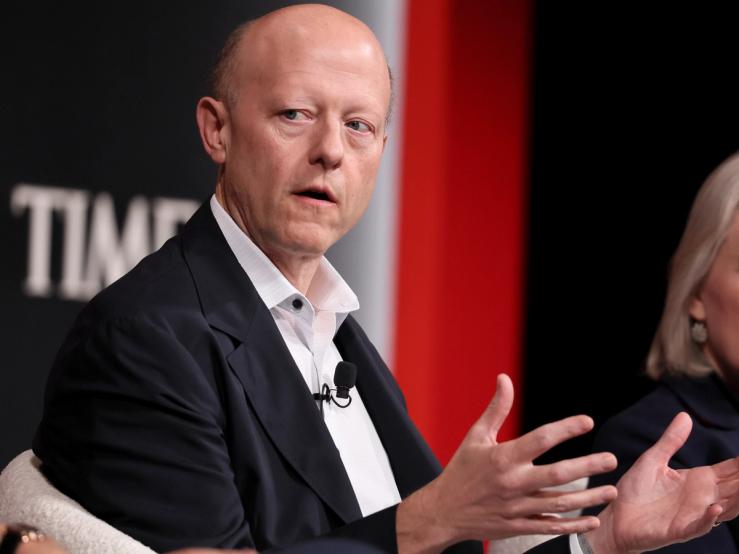The Signal Interview
“Big day,” Donald Trump remarked to Circle’s Jeremy Allaire at a White House event last month, where the president established a legal framework for stablecoins — digital assets pegged to currencies such as the dollar — by signing the GENIUS Act.
The landmark legislation followed intense lobbying by a cryptocurrency industry Trump’s predecessor, Joe Biden, viewed with suspicion. For Allaire, the co-founder and CEO of stablecoin issuer Circle, the bill’s passage was “an incredible moment,” and vindication after he spent 12 years pushing a project that he always knew would require sweeping legislative change to succeed.
It also came on the heels of an initial public offering that captured Wall Street’s newfound enthusiasm for digital assets. Circle raised $1.2 billion in its listing in June, and its stock promptly soared. The company’s market capitalization has fallen from its peak but remains above $30 billion, or almost 20 times its revenue last year.
But the legislative and market tailwinds now propelling Allaire’s company and industry contrast with the “deep skepticism” he has encountered since launching Circle in 2013. “I’ve told almost everyone I’ve hired that this is going to be the hardest job that you’ve ever had,” he says.
‘Are you out of your mind?’
Allaire and Sean Neville founded Circle in 2013, but Allaire traces its origins back to 1990, when he first became “enthralled” with the potential of the internet’s open architecture to transform media, communication, and the global economy. After the global financial crisis, he became “kind of obsessed” with questions like, “How did this happen? And what is the nature of money?” he recalls. “Before I knew anything about crypto or blockchains or any of this, I was convinced that there had to be a better way to construct the financial system.”
When he was introduced to bitcoin in 2012, he saw it as “the birth of a new infrastructure layer of the internet,” akin to communication protocols like HTTP or the video protocols he used at Brightcove, the digital video business he founded. And that, he thought, opened the way for a digital currency backed by dollars or assets like US Treasury bonds that could “make the storage and movement of money as seamless, and ultimately, as cost-efficient as the storage and movement of data and communications.”
Circle launched its stablecoin, USDC, in 2018 and reported earlier this month that the amount of USDC in circulation grew 90% to $61.3 billion between June 2024 and June 2025. But Allaire says he only got to this point after overcoming a series of challenges that “seemed existential and were existential.”
Disruptive new technologies require new laws, Allaire observes, listing stablecoins alongside drones, self-driving cars, and AI as innovations that “reshape what’s possible in society” and so challenge existing regulatory frameworks. Most people looking at a startup that depended on changing policy around the world would ask, “Are you out of your mind?” he says. “But to me, that was extremely motivational.”
A 12-year battle to convince the skeptics
Concerns about cryptocurrencies’ popularity among criminals and terrorists have stalked Circle from the start. When Allaire first testified to the US Senate in 2013, it was alongside experts in financial crimes and homeland security. Before he could convince outside investors to put money in, he used his own funds to hire consultants to establish whether the idea behind Circle was even legal. Auditors and insurance companies would not return his calls “because people thought, ‘Oh, these guys might be criminal.’”
Even now that stablecoins have found bipartisan support in Washington, Allaire is still fighting critics, from academic economists to the Bank for International Settlements, who warn that stablecoins pose risks to financial stability. The doubters are guilty of “reductio ad absurdum” logic, Allaire contends, saying that his vision for the “internet financial system” will instead be safer, more transparent, and less risky.
Many CEOs despair of their dealings with lawmakers, and Allaire admits “there have been moments where I want to pull my hair out.” But having recognized that stablecoins would need new legislation, he was determined to shape it.
“That became a founding principle for the company, [that] we’re going to go in through the front door with policymakers and regulators,” he says. “You’ve got to work with governments. There’s no way around it.” OpenSecrets reports that Circle spent $230,000 on lobbying Washington last year and made more than $1 million in political donations.
It has been “an absolutely huge effort” to convince the skeptics, Allaire says. He’s also sought to do that by investing heavily in compliance and risk management as he built Circle.
“Magic happens in this particular area when you can get technical innovation and risk management to work well together,” he says. But he adds that one of his toughest challenges has been balancing “the energy of engineers and product leaders and people who want to build stuff” with the more cautious culture of employees looking to contain risks.
The ‘spouse acceptance factor’ in getting employees on board
Convincing investors to back Circle was relatively easy, Allaire says, because of his record in previous companies, including Macromedia, General Catalyst, and Brightcove. The harder part was getting over “the spouse acceptance factor” with would-be employees.
Allaire says he likes to recruit “interdisciplinary thinkers” — people who know more than he does in the domains which he is hiring them to focus on, but who can also understand the novel legal, technological, and macroeconomic issues and risks facing a business like Circle. Hiring and motivating people in the face of “constant skepticism” has been a challenge. “They’ve got to go home to their spouse and say, ‘I’m going to join this company, and here’s what they’re trying to do,’” he observes. And the only way for founders to win over potential recruits and their spouses is to ground their conviction in a compelling vision of what the new hires will be working towards.
The mission that has got people on board, Allaire says, is that if Circle can make it as easy to use money as it is to find information on the internet, it can help raise global economic prosperity, improve the way the economy functions, and enable more people around the world to participate in the financial system.
“They have to believe in the mission. They have to believe that, even in the face of huge challenges, it’s possible to do,” he says. “It’s that anchoring in that vision and mission, which is what retains people and keeps them going.”
Allaire’s vision of a ‘winner-takes-most’ future
Competition is growing from other stablecoin issuers, including Tether and World Liberty Financial, a group backed by Trump and his sons. But Allaire maintains that Circle has a competitive advantage. Its core product is not a stablecoin, he says, but a stablecoin network which becomes more useful to more people as developers build applications on it. “So, like other internet utilities, we have these platform network effects, and that is a very significant competitive advantage,” he says. “If you’re building a product or service on the internet and you want to use digital dollars in the form of stablecoins, you almost have to support USDC, because it’s so widely available and so widely integrated.”
As Circle strikes more partnerships with the likes of BNY and Intercontinental Exchange, he sees it becoming “a significant player” in a “winner-takes-most” market.
As significant as the passage of the GENIUS Act is for Circle, Allaire sees the legislation as just “the starting gun” in a long race towards the new “internet financial system” he believes stablecoins are establishing.
“A new way of organizing labor and capital” is coming, he says, where corporate contracts, ownership, and governance are all mediated on blockchains. Circle’s new offices, whose conference rooms are named after history’s great commercial hubs, look down on a Wall Street that Allaire’s creation stands to disrupt.
“The internet is colliding with the global financial system,” just as it did with software, communications, and commerce, he says, and that will create “extraordinary opportunities” to improve the way money, credit, and the capital markets work.
Companies that embrace the technology early will improve the utility of their products and find efficiencies, Allaire predicts. The laggards may suffer over the long run, he thinks, “but this is a long arc. These things take many decades. I meet with a lot of these top institutions, and they all see this as an opportunity space. Figuring out exactly how is sort of their next job.”
Notable
- After the GENIUS Act, the crypto industry’s next goal is a permanent overhaul of how federal agencies regulate cryptocurrencies. But as one crypto advocate told Semafor’s Eleanor Mueller: Not only is the market structure bill not “ready for prime time this year,” there’s a chance “it never happens.”


